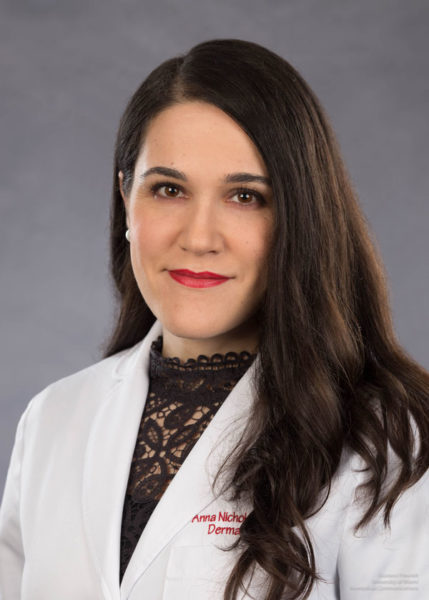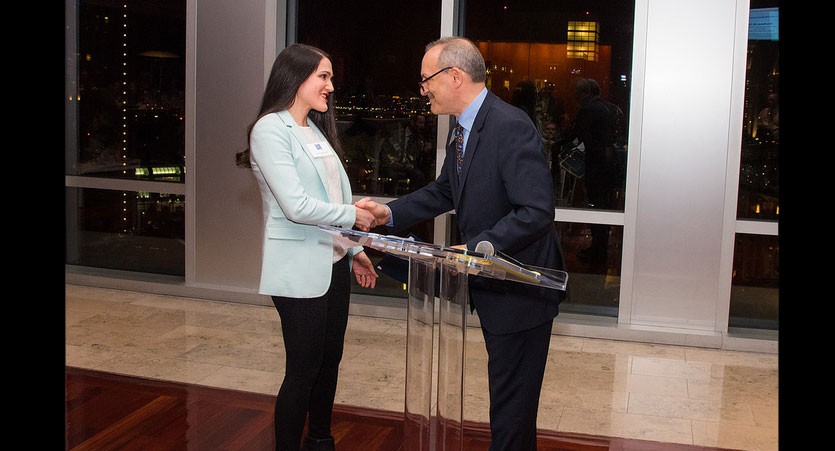How Anna Nichols used her Skin Cancer Foundation research grant to kick-start an exciting and promising experimental treatment for skin cancer.
By Mark Teich
In the 38 years since The Skin Cancer Foundation initiated its Research Grants program, many young investigators have used their grants to launch studies that ultimately led to major contributions in the field. One who may follow in their footsteps is Anna Nichols, MD, PhD. Perhaps no one has made a more immediately promising splash with an SCF grant than she did.
Dr. Nichols, an assistant professor in the Dr. Phillip Frost Department of Dermatology and Cutaneous Surgery at University of Miami Miller School of Medicine, received the SCF’s $25,000 Ashley Trenner Research Grant Award in February 2018. Within months, she had published a case report in JAMA Dermatology about her experimental new treatment for locally metastatic squamous cell carcinoma (SCC) of the skin. Employing the human papillomavirus (HPV) vaccine, Gardasil (more precisely called Gardasil®9), she had eliminated dozens of tumors in a previously untreatable 97-year-old woman. While a study of just one patient, it has generated considerable excitement and buzz. The goal now for Dr. Nichols and her team will be to see if its success can be applied to other patients.
“I met Mrs. McKenzie when I was a resident and she was 97,” Dr. Nichols recalls. “She’d had a tumor removed two years before from her lower leg, but when I first saw her, she had multiple, locally metastatic lesions (metastasized all over her leg but not beyond) that were continuously bleeding and not healing. She had too many tumors to remove them all surgically, radiation was not an ideal option and both topical and injectable therapies had previously failed. She had been offered systemic chemotherapy that would have involved serious side effects without providing much certainty, but she wasn’t willing to sacrifice quality of life.”
Dr. Nichols and her collaborators at the University of Miami, Robert Kirsner, MD, Evangelos V. Badiavas, MD, and Tim Ioannides, MD, had previously published a paper showing that the Gardasil vaccine helped prevent the growth of new tumors in two patients with a history of multiple skin cancers. Her colleague Dr. Ioannides urged her to try a radical new approach — to use the vaccine off-label (for a different purpose than the one for which it was originally approved) as a treatment to rid her patient of the existing lesions. After first administering the vaccine systemically through two intramuscular injections into the woman’s arm, Dr. Nichols had noticed a local inflammatory response in the majority of the tumors. Since other vaccines had successfully been injected intratumorally (directly into the tumor) to treat other maladies, she and Dr. Ioannides thought, Let’s try that.
She injected the vaccine into each of the woman’s three largest tumors twice, and the lesions started shrinking within weeks. Other tumors started shrinking as well, so she reasoned that the woman’s immune system may have been having a systemic response to the medicine, and that she wouldn’t have to inject all the tumors to clear them up. She injected the largest tumors two more times, each time using a smaller dose, for a total of four injections. Within a year, every tumor had disappeared.
What the Grant Accomplished

Anna Nichols, MD, isn’t restrained about her ambitions as a researcher. “I don’t want to learn about a few molecules 10 years down the road,” she says. “I want to get that data everyone is dying for.”
When Dr. Nichols applied for the grant in 2017, she proposed a broad focus exploring the potential of the HPV vaccine as a systemic immunization to prevent SCCs as well as a treatment for SCCs by injecting it directly into existing tumors. In awarding her the grant, the SCF’s Research Grants Committee stipulated that she focus on the treatment aspect, since it appeared to have the most exciting potential. That’s what Dr. Nichols did with her inoperable patient, Mrs. McKenzie. Since publishing her case report, she has presented her findings at the 2018 World Congress on Cancers of the Skin in Sydney, Australia, and on March 26, 2019, Dr. Ioannides was awarded a patent for this novel use of the Gardasil®9 vaccine. With this green light, Dr. Nichols is now dedicated to uncovering the mechanisms behind this promising treatment.
“We’re still in the infancy stage,” she explains. “We know the treatment works in some people, but finding out how it works and whom it works best for is challenging. It’s difficult to successfully compete for funding without this fundamental knowledge. That’s the catch-22: You need to generate data to get funding, but you can’t produce the data without funding.” The SCF’s seed money has allowed her to start generating that data.
“With what I’ve already found, people are getting interested both nationally and internationally. The Foundation’s grant has helped me focus on the intratumoral treatment, which I think has the greatest potential impact. Grants also give you protected time to focus. More funding means more time that I can concentrate on research.”
The Caring Donors Who Funded This Research
Karen and Bob Trenner established their annual SCF grant after their daughter, Ashley, died from melanoma at just age 34. Her dying wish was to save lives, and while melanoma deaths have decreased due to earlier detection and new medications, deaths from SCC are about twice as high as melanoma deaths. Dr. Nichols would love to pay back the Trenners by sending SCC deaths plummeting.
“Donor grants like the Trenners’ are huge for early career researchers like me, who are thinking out of the box with new ideas,” she says. “We’re not the safe option. It’s a high-risk project with a huge upside if it works, but few want to take a chance on it.” Without this type of seed money grant, worthy projects can easily die, since there’s no way to get funding without preliminary data. Promising research like Dr. Nichols’ project needs a lot of money to do it right and to uncover the mechanism behind its success.
“Then you want to expand on this and find out why it works in some patients and not in others,” adds Dr. Nichols. “I thank the Trenners so much for giving the project a chance. It is allowing me the opportunity to start generating the preliminary data that will help me compete for larger grants funding bigger studies in the future.”
Dr. Nichols’ paper was cited as one of the top 10 most talked about articles of 2018 for JAMA Dermatology. “Among other things, the before and after pictures of our patient are unbelievable,” says Dr. Nichols. “You don’t need statistical analysis to appreciate the improvement. First, you see tumors everywhere, all over her leg, and then zero. Not a 20 percent reduction, but a 100 percent reduction.”
“We can’t promise spectacular results in other patients, because we don’t understand the mechanism yet,” she says. “But I hope that in the future many patients will benefit from this innovative line of research. It will all have started with the SCF’s grant.”
The Proof Is in the Fruitcake
During her treatment, Mrs. McKenzie baked her signature fruitcake for Dr. Nichols, who had quickly become her friend. Her family became close to Dr. Nichols too: Once, when Mrs. McKenzie’s son brought her in for a visit, Dr. Nichols commented on her lovely pink scarf, which her son explained came from Italy. When he came back from his next trip to Italy, to Dr. Nichols’ surprise, he brought her an identical pink scarf.
Since Dr. Nichols treated Mrs. McKenzie, she has remained tumor-free. She celebrated her 100th birthday with a party at her house. Dr. Nichols joined friends and family in celebrating this exceptional woman’s century of life.
All of this has touched Dr. Nichols’ heart, reinforcing her already fierce desire to see thousands of once hopeless patients celebrating like this. “I did my residency at the University of Miami, and I saw a large population of patients who had such frequent tumors that you couldn’t keep up with them. They had terribly damaged skin, with many tumors, and for some patients there were no viable treatments. I wanted to do more for these patients who had so few options. We need something more to offer them.”
Dr. Nichols is now using the off-label vaccine treatment on several other patients, with many waiting in the wings. And she is putting together a clinical trial. “We want to push the boundaries and move medicine forward. We’ve dramatically changed one patient’s life, and I hope there will be many more to come.”

*This article was first published in the 2019 issue of The Skin Cancer Foundation Journal.





